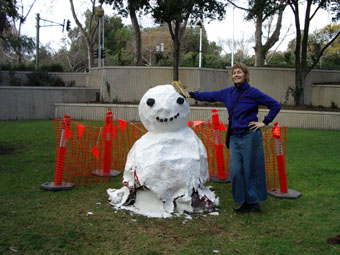Sarah CrowEST
Linda Marie Walker

Sarah CrowEST, snow creature
I’ve known of Sarah CrowEST’s work for a long time, yet it’s hard, now, to define it—which is its strength, and its vulnerability (in the best sense). Coming from an established craft background in textiles, the move into arts practice is a mere footstep, an addition and an elasticity. And, language means everything in this move, or movement between and across genres. In CrowEST’s work every move makes a difference—this is the great continual break (and breaking): that everywhere/place is the space of making and showing: unofficial streets, official public space, art gallery, craft gallery. The work seems, overall, one of secreted memory, ambivalent about where things should, or could, or will be. And more, how they might appear, or make an appearance in the world (eg how will a ‘snow creature’ cope in an Adelaide winter). Small passive creatures live in boxes, and other creatures want to live there too; the places we make, make others placeless. This strange divide between place (unconditional) and placelessness (contingent) is a political imperative—how do we regard others (will the black ‘beetles’ crawling up the side of the boxes be welcomed?).
CrowEST makes boxes for those who seem to belong—weird creatures anyway. Other ‘things’ become ‘blobs’; rounded, stone-like, fabric coated shapes—not quite seamless–replete with ‘what’ they might be…tomorrow. Pregnancy is a dangerous state, the benign appears quiet (as hell). There are too many extraordinary works to write of, each finely realised, like the exhibition at Downtown Art Space, earlier this year, where, in the catalogue, Bridget Currie wrote: “A slow heart beating. In parts, the delicate hairiness of spores, mould mounds, fungal bloom…Moist sludgy love.” It is a particular poetic that Currie engages–an illicit quietness. CrowEST’s latest work snow creature, part of BUILT! an ephemeral public art project (an Adelaide Festival Centre Trust Visual Arts initiative), was bashed the first night it took up its position at the King William Street side of the centre. CrowEST repaired it for the next day’s opening. The snow creature was there for 20 days, and continued to be ‘bashed.’ Perhaps all ‘snowmen’ are beaten and broken; that could be their ‘invitation.’ Still, it was a stranger in our midst, incongruous, small, even lost. Sarah CrowEST’s work questions whether care is possible in the face of incomprehension.
RealTime issue #57 Oct-Nov 2003 pg. 7






